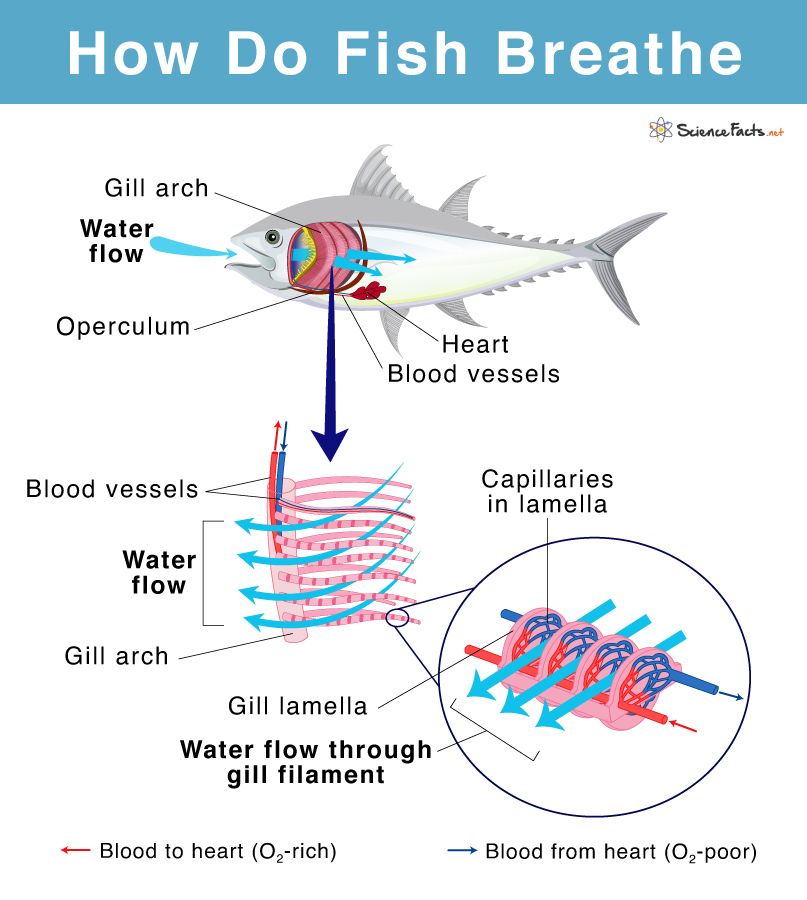How do Fish Breathe
Like any other living entity, fishes also breathe to survive. They take up oxygen and expel carbon dioxide as the waste product. The oxygen helps to break down their ingested food and release energy. So, there is a demand for a constant supply of oxygen to carry out all their physiological life processes.
Unlike land animals, including humans that use lungs to take in oxygen directly from the air, fishes use a specialized organ to obtain oxygen dissolved in water.
What Do Fish Use for Breathing
Fishes perform breathing using a specialized filter-like organ called gills. Gills are found on both sides of their head, protected by a bony cover called the operculum.
The breathing process in fish requires large volumes of water to pass through their bodies to get enough oxygen. Gills increase the surface area for better absorption of gases, thus aiding in gas exchange. Also, the large surface area is crucial as water contains a very low quantity of dissolved oxygen (4 to 8 parts per million).
How do They Breathe Underwater
The process of breathing starts when a fish gulps water through its mouth. This oxygen-rich water is then pumped over their gills. When water passes over the thin walls of gill filaments, the blood within the capillary network takes up the dissolved oxygen. After entering into the bloodstream, the circulatory system of the fish distributes the oxygen to all its body tissues. Simultaneously, the carbon dioxide is taken up by the blood and eliminated out of the body through the gills. This is how fishes perform gas exchange in water.
The direction of blood passing through gills and the direction of the water flowing over the gills are opposite. Therefore, it helps keep the blood oxygen level less than the oxygen level in the water. Consequently, oxygen diffuses into the blood, i.e., it moves from higher to lower concentrations. It then combines with hemoglobin (a protein in red blood cells) that supplies oxygen throughout the fish body.
Do Fish Breathe Air
Though there are some exceptions, most fishes do not breathe air, as they lack lungs.
Why Can’t Fish Breathe On Land
Although there is abundant oxygen in the atmosphere, unfortunately, most of the fishes cannot breathe out of the water as their gills collapse on land. Let us understand why this happens?
Gills are composed of numerous thin, comb-like, or hair-like filamentous projections called gill lamellae to increase surface area in a small space. The gill filaments remain separated and function by taking the water through the mouth, allowing it to flow steadily through the gills. However, when a fish is taken out of the water, the gills crumple, stick together, and become dry. Thus, it fails to breathe out of water.
Also, being lighter, the projections on the gills float on water. As a result, each of the gill filaments remains surrounded by water from which it can absorb oxygen. Nevertheless, as gills collapse on land, the surface area gets reduced, and the fish suffocates.
Exceptions: Air-Breathing Fish and Mammals Living in Water
Some fishes like walking catfish (Clarias batrachus), Asian stinging catfish or fossil cat (Heteropneustes fossilis), three spot gourami (Trichopodus trichopterus), climbing gourami ( Anabas), paradise fish (Macropodus), and Siamese fighting fish (Betta splendens) possess unique adaptation to survive on land. They breathe atmospheric air using unique respiratory structures like modified air bladder, lungs, skin, or gills.
Another exception is found in Dolphins and whales that have a streamlined body, have fins and tails just like fishes. They breathe air through their nose (commonly called a ‘blowhole’) and using their lungs. Thus they classify as mammals and not as ‘fish’.
-
References
Article was last reviewed on Wednesday, February 1, 2023




